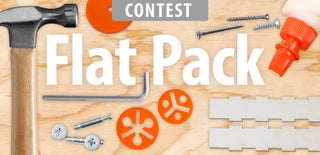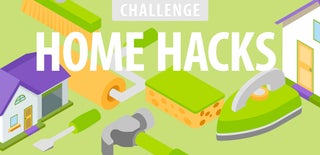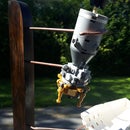Introduction: Collapsible Light Box for Easy Storage
Recently I opened a small Mom and Pop style shop in my home town. Part of being a shop owner is advertising your products on social media in order to stay competitive. Now, it's not enough just to get your products seen, they need to be aesthetically pleasing as well, which means they need good lighting and proper contrast and that means that you need a good light box.
One of the biggest problems with Mom and Pop style shops, is they often come in a Mom and Pop sizes where space is at a premium, and every square inch of storage is used as wisely as possible. Attempting to store a large cardboard and foam box is counterintuitive to good space management.
This project required making a light box that could be assembled in a moment's notice, then disassembled again and stowed away in as compact a space as possible. For stability, I used foam core board, that is readily available at any craft or dollar store employing a mortise and tenon style of construction requiring no tape, or glue to hold it together. Its design allows for both front and top down photos to be taken, allowing any object being employed to be photographed from any angle.
Step 1: Tools and Supplies
Tools;
- Utility Knife
- Ruler (Meter and 12")
- Cutting Mat
Supplies;
- 3 Sheets of White Foam Core Board
- 1 Sheet of Poster board
- Stick on LED lights (one will work, but several will remove more shadow)
Step 2: The Design
The overall size of the light box is 15"x15", tho your own version can be scaled up or down as necessary. It incorporates 3 sides with an optional 4th for top down images and a 'deck' to support any object being photographed. With the 4th side in place, the lid can be lifted giving access for the top down perspective. You will need to add mortise notches to the front of the side pieces to accommodate this 4th side.
The sides, front and deck are cut out of individual pieces while the back and top are one piece, hinged at the corner. The design utilizes a mortise and tenon joint system that holds all of the pieces securely in place, at the same time allowing the pieces to be easily removed without any extra tools for seamless storage. The body of the box uses a foam core cardboard, however there is an additional backdrop made out of poster board that serves to hide any corners creating a solid white background. This backdrop can be replaced with black poster board for use with lighter objects requiring a dark background.
As the design diagram is pretty easy to follow, I won't be explaining each side individually. Rather, I'll explain the cuts required to create each piece, including the mortise and tenon joints, and the creased bend in the lid/back and deck.
Step 3: Cutting Foam Core Board
The fantast thing about foam core board, other than its working rigidity, is that it can be cut very easily leaving smooth straight lines. The process is simple. Foam core uses a layer of polystyrene foam sandwiched between two sheets of card stock. Once you've marked your cut location, using your utility knife, and a straight edge, score a line through the card stock on one side of your board. Then flip over your FC board and mark the location of the score on the opposite side. You can use the edges of your score to find the exact line. Next lay your ruler right to the edge of the score and begin lifting one edge until the board is 90 degrees. The foam should 'pop' exactly along the seam leaving a nice smooth edge. Finally, using your ruler's edge, score through the cardboard on the remaining side and the pieces will separate nicely.
Step 4: The Tenon Joints
I standardized the joints making the mortise and tenons as 1.5", 7.5", and 13.5" on center and decided on a length of 1". In hindsight, I probably would have made them a bit longer at 1.5" - 2" as it would go a long way to making them stronger. I'd definitely recommend that you make this adjustment in your light box. The only exception is the lip of the platform that hangs down 1.5" in the front of the box. For its tab, I created it .5" long, and adjusted the 13.5" tenon on the 'C' and 'D' sides of the back to 12" on center to compensate.
To start, mark your tenon positions at the three measurements, then measure the width of the tenon across it. I.E. .5" on either side for a 1" tenon. You'll need to cut straight through both sides of the material for the edges of the tenon, which is why you should have a cutting mat on hand, then using the same score and fold technique you used cutting down the overall size of the board, remove the extra material between each tenon.
Step 5: The Mortise Joint
The mortise joints are made slightly smaller than the tenons to ensure that they fit tightly and don't slip apart. Where the tenons were 1" wide, I created the mortises 7/8" wide making a snug fit.
Cutting the edge mortise joints is profoundly simple, provided you use the same position measurements that you used on the tenons. Again, you'll have to cut straight through both layers of material for the edge of the mortise, however the score and bend technique will work here as well.
You'll need to make mortise joints at 1.5" from the bottom edge to support the deck, which can be a bit trickier to cut out neatly. The technique I used was to score the shape out of one side, then using a pin, I poked all four corners cleanly through the other side, allowing me to flip it over and mirror the cuts exactly. Afterward, it's simple enough just to push the material out leaving a nice clean mortise.
Step 6: The Corner Hinge
Both the top/back and the deck use a corner hinge for extra strength. You can simply score one side and bend it with the split side outward, however, over time it will weaken and tear. The most effective way to create the hinge is to double score your line, removing the material between then installing it with the score on the inside of the hinge.
When I first created my hinge, I made it 1/4" wide, thinking it needed the extra space, however I found it was a bit flimsy and reduced the split to 1/8" which was both strong and flexible.
The process is simple; Score two lines through one side of your FC board 1/8" apart, then using the bend technique, 'pop' the foam core at each line. Next, you can insert your utility knife under the spare material and begin to remove it. It should peel away easily from the intact side of your board leaving a gap between the two halves. It's that simple.
Step 7: The Backdrop
The backdrop is useful for reflecting light back up toward the object being photographed and also for hiding the corners from the camera's view, creating a crisp white background without texture.
Cut your poster board down to 14.5"x24". Next you'll need to create the tabs that will hold it in place but also make it easy to remove. I made them 1.5"x 1" and 5" apart. Next, using my utility knife, I scored two slots in the hinge of the top/back side using the same measurements and inserted the tabs in the backdrop into them. Then I simply folded them down which held the backdrop securely, but not permanently into place.
Step 8: The Shadow Lights
I only used one light, initially, however I've since added 3 more. These are simple peel and stick LED lights that I purchased from the Dollar Store. They are completely optional, however having light in the top will help reduce the amount of shadow cast by the object being photographed while being lit from the front. I'd definitely recommend installing them.
Step 9: Finished
That's it. A simple and inexpensive light box that will make your pictures pop and giving you more control over your subject.
As usual, I hope you enjoyed the instructable and thanks for following.

Runner Up in the
Flat Pack Contest

Participated in the
Home Hacks Challenge













